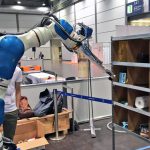 Automation has impacted a wide range of areas, but perhaps nowhere more so than in retailing, where machines have been increasingly deployed in areas such as stock control and logistics.
Automation has impacted a wide range of areas, but perhaps nowhere more so than in retailing, where machines have been increasingly deployed in areas such as stock control and logistics.
It’s perhaps no surprise therefore, that Amazon are spearheading such efforts to automate retailing, with their Robotics Challenge a key aspect of their attempts.
One of the more interesting entrants from the challenge, which concluded recently, was the team from Karlsruhe Institute of Technology’s (KIT) Institute for Materials Handling and Logistics.
“In an exciting week with three intensive competition days we mastered several challenges and learned a lot,” the team say. “It was a big success for our young team to be able to compete with the best in the world in Japan.”
Innovative shelving
The team’s solution was an innovative shelf concept. Whereas traditionally, goods are arranged on layered shelves, the KIT team placed goods in mobile boxes arranged horizontally around a central robotic arm. The boxes can then be moved by the machine like they would a drawer. It allows for a multistory type setup.
“As today’s warehouse systems have reached their technical limits, we wanted to develop a completely new system for the 21st century in order to make full use of the advantages of the robot gripper,” the team say.
The aim is that all of the actions required by such a device, whether detecting items, picking them up or dropping them back down again, can be performed using very similar movement patterns. This makes the robot itself quicker and more reliable. The system also comes with a laser scanner, not unlike those used in autonomous vehicles, to monitor the area and help the robot navigate the warehouse.
Whilst the technologies on display in the Amazon challenge are very early stage, retailers such as Ocado are bringing this kind of technology to market here and now. For instance, earlier this year they showcased a robotic picker.
The picker is designed to handle the full 48,000 or so items currently stocked by Ocado, and it will do so via compliant robotic hands that are specifically designed to handle fragile objects, even with minimal knowledge as to the shape of the item.
They also announced an open source package design, called Kubermesh, which is designed to simplify data center architectures for use in smart factories. The system uses container-based technology to implement private cloud architecture on-site, with desktop computers configured to replicate the kind of computational and storage capabilities typically offered by high-end servers in data centers.
“Kubermesh is an elegant and cost-efficient solution to running our highly-automated Customer Fulfillment Centers based on a distributed network of computing nodes spread around the warehouse rather than high-performance servers concentrated in one large data center. This is a bold idea that has the potential to revolutionize the way companies approach on-site data center architectures. Thanks to the power of open source software such as Kubernetes, our platform automation team was able to quickly design a working prototype and develop it further based on advanced simulations of our future warehouse automation requirements. We’re very excited to continue unlocking the potential of container technology at Ocado and hope that the open source community uses Kubermesh in new and exciting ways,” Ocado say.
It’s perhaps not the most glamorous area, but there are fascinating strides being made. Anyway, check out the video below to see the KIT machine in action.